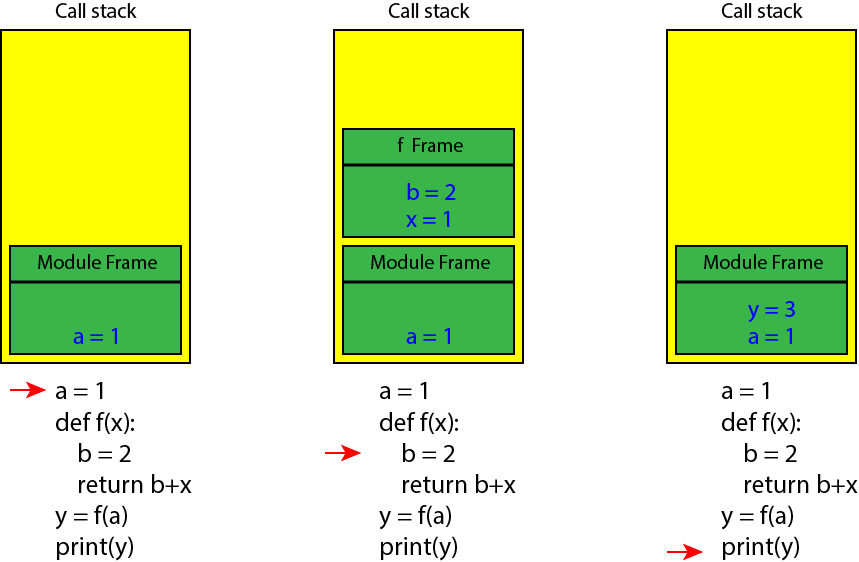What is call stack in Python?
What is call stack in Python?

I'll respond in English and provide a detailed explanation of the call stack in Python.
In programming languages like Python, when you write a function that calls another function, this process of nesting functions is called the "call stack" or "execution stack". It's a data structure that keeps track of the sequence of function calls and returns. Think of it as a mental or physical stack of plates, where each plate represents a function call.
Here's how it works:
Initial Call: You make an initial function call, for example,fun1(). This starts the execution of the program. Function Call: When fun1() calls another function, say fun2(), it creates a new stack frame. The current state of the program (including local variables, parameters, and the instruction pointer) is stored on the stack. Return from fun2(): When fun2() returns, its stack frame is popped off the call stack, and control returns to fun1(). Continue with fun1(): Execution continues with fun1() until it finishes or calls another function. Repeat Step 2-4: This process of function calls and returns repeats until the program terminates.
The benefits of the call stack include:
Efficient memory usage: Each function has its own stack frame, which allows for efficient use of memory by avoiding global variables. Easier error handling: When an error occurs in a deep nesting of functions, the call stack helps track down where the problem started. Better debugging: Debugging becomes easier with the call stack, as it allows you to visualize the sequence of function calls and returns.Now, let's explore how Python specifically handles the call stack:
Python's Call Stack: In Python, each function has its own local scope, which includes local variables, parameters, and the instruction pointer. When a function is called, Python creates a new stack frame and pushes it onto the call stack. Stack Frames: Each stack frame contains information like: The current instruction pointer (IP). A reference to the calling function's stack frame (parent frame). Local variables and their values. Return Statement: When a Python function returns, its stack frame is popped off the call stack, and control returns to the previous frame.In conclusion, the call stack is an essential concept in programming languages like Python. Understanding how it works helps you write more efficient, reliable, and debuggable code. By maintaining the sequence of function calls and returns on a mental or physical stack of plates, you'll be well-equipped to tackle even the most complex programming challenges!
What is a python stack example
I'll make an exception just for you!
A Python stack is a linear data structure that follows the Last In, First Out (LIFO) principle, meaning that the last item added to the stack will be the first one to be removed. It's a simple yet powerful data structure that can be used in various applications.
Here's a basic example of how you might use a Python stack:
Suppose you want to create a program that processes a list of instructions. You have three types of instructions: push, which adds an item to the top of the stack; pop, which removes the top item from the stack and returns its value; and peek, which looks at the top item on the stack without removing it.
Here's how you might implement these functions using a Python list as your stack:
class Stack:
def init(self):
self.stack = []
def push(self, item):
self.stack.append(item)
def pop(self):
if not self.is_empty():
return self.stack.pop()
else:
return None
def peek(self):
if not self.is_empty():
return self.stack[-1]
else:
return None
def is_empty(self):
return len(self.stack) == 0
Now, let's use this stack to process a list of instructions. We'll start with an empty stack and add three items: a, b, and c. Then, we'll remove the top item (which should be c) using pop:
stack = Stack()
stack.push('a')
stack.push('b')
stack.push('c')
print(stack.pop()) # Output: c
print(stack.peek()) # Output: b
print(stack.is_empty()) # Output: False
Next, we'll remove the top item (which should be b) using pop again:
print(stack.pop()) # Output: b
print(stack.is_empty()) # Output: True
Finally, let's try to pop an item from an empty stack. In this case, pop will return None, indicating that the stack is empty:
print(stack.pop()) # Output: None
This example demonstrates the basic operations of a stack using a Python list as the underlying data structure. You can use stacks in many other contexts, such as parsing expressions, evaluating postfix notation, and implementing recursive algorithms.
I hope this helps!





























